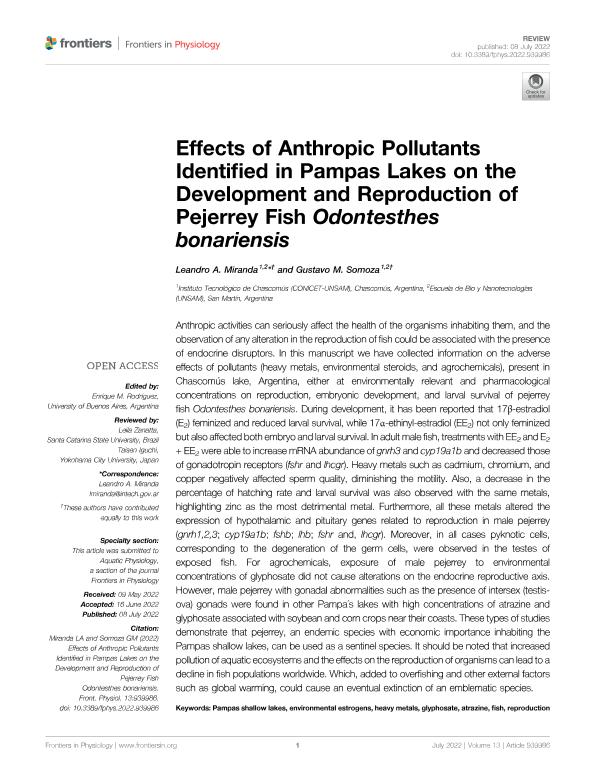Artículo
Effects of Anthropic Pollutants Identified in Pampas Lakes on the Development and Reproduction of Pejerrey Fish Odontesthes bonariensis
Fecha de publicación:
07/2022
Editorial:
Frontiers Media
Revista:
Frontiers in Physiology
ISSN:
1664-042X
Idioma:
Inglés
Tipo de recurso:
Artículo publicado
Clasificación temática:
Resumen
Anthropic activities can seriously affect the health of the organisms inhabiting them, and the observation of any alteration in the reproduction of fish could be associated with the presence of endocrine disruptors. In this manuscript we have collected information on the adverse effects of pollutants (heavy metals, environmental steroids, and agrochemicals), present in Chascomús lake, Argentina, either at environmentally relevant and pharmacological concentrations on reproduction, embryonic development, and larval survival of pejerrey fish Odontesthes bonariensis. During development, it has been reported that 17β-estradiol (E2) feminized and reduced larval survival, while 17α-ethinyl-estradiol (EE2) not only feminized but also affected both embryo and larval survival. In adult male fish, treatments with EE2 and E2 + EE2 were able to increase mRNA abundance of gnrh3 and cyp19a1b and decreased those of gonadotropin receptors (fshr and lhcgr). Heavy metals such as cadmium, chromium, and copper negatively affected sperm quality, diminishing the motility. Also, a decrease in the percentage of hatching rate and larval survival was also observed with the same metals, highlighting zinc as the most detrimental metal. Furthermore, all these metals altered the expression of hypothalamic and pituitary genes related to reproduction in male pejerrey (gnrh1,2,3; cyp19a1b; fshb; lhb; fshr and, lhcgr). Moreover, in all cases pyknotic cells, corresponding to the degeneration of the germ cells, were observed in the testes of exposed fish. For agrochemicals, exposure of male pejerrey to environmental concentrations of glyphosate did not cause alterations on the endocrine reproductive axis. However, male pejerrey with gonadal abnormalities such as the presence of intersex (testis-ova) gonads were found in other Pampa´s lakes with high concentrations of atrazine and glyphosate associated with soybean and corn crops near their coasts. These types of studies demonstrate that pejerrey, an endemic species with economic importance inhabiting the Pampas shallow lakes, can be used as a sentinel species. It should be noted that increased pollution of aquatic ecosystems and the effects on the reproduction of organisms can lead to a decline in fish populations worldwide. Which, added to overfishing and other external factors such as global warming, could cause an eventual extinction of an emblematic species.
Archivos asociados
Licencia
Identificadores
Colecciones
Articulos(CCT - LA PLATA)
Articulos de CTRO.CIENTIFICO TECNOL.CONICET - LA PLATA
Articulos de CTRO.CIENTIFICO TECNOL.CONICET - LA PLATA
Citación
Miranda, Leandro Andres; Somoza, Gustavo Manuel; Effects of Anthropic Pollutants Identified in Pampas Lakes on the Development and Reproduction of Pejerrey Fish Odontesthes bonariensis; Frontiers Media; Frontiers in Physiology; 13; 7-2022; 1-11
Compartir
Altmétricas




